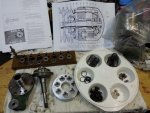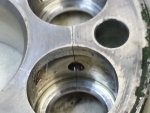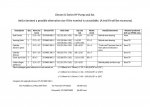Having created the tool mentioned in the "Special Tools" sticky, I've used it in anger to dismantle my spare 7 cylinder pump.
As expected, it's got a cracked pump body. I say "as expected" as while it worked when I tried it on Moby a couple or more years back, it was very slow and reluctant to raise enough pressure to function properly. This seemed to indicate an internal leak, and such was the case.
So now I have the dilemma.
I know I can buy a rebuilt unit from Roger Parker.
I know I can get a new pump body and seals from Der Franzose.
Both of these options appear a bit expensive, but are both achievable. Only one of these will provide me with the satisfaction of reassembling a pump and having it work as God and Citroen intended.
If I can obtain a second hand pump body then I only need to buy a set of seals as the pistons etc are all seemingly in excellent condition.
So the question is, does anyone out here have one or two pumps that may have an uncracked body that they will sell to me?
Obviously we don't know if the body is cracked until it's at least got the cover off. That's why I've said one or two to try and increase the chances of striking gold.
I await responses with bated breath.
For everyone's edification and delight Here's a photo of the bits of pump laid out and a closeup of the offending crack.
Cheers for now, Pottsy
As expected, it's got a cracked pump body. I say "as expected" as while it worked when I tried it on Moby a couple or more years back, it was very slow and reluctant to raise enough pressure to function properly. This seemed to indicate an internal leak, and such was the case.
So now I have the dilemma.
I know I can buy a rebuilt unit from Roger Parker.
I know I can get a new pump body and seals from Der Franzose.
Both of these options appear a bit expensive, but are both achievable. Only one of these will provide me with the satisfaction of reassembling a pump and having it work as God and Citroen intended.
If I can obtain a second hand pump body then I only need to buy a set of seals as the pistons etc are all seemingly in excellent condition.
So the question is, does anyone out here have one or two pumps that may have an uncracked body that they will sell to me?
Obviously we don't know if the body is cracked until it's at least got the cover off. That's why I've said one or two to try and increase the chances of striking gold.
I await responses with bated breath.
For everyone's edification and delight Here's a photo of the bits of pump laid out and a closeup of the offending crack.
Cheers for now, Pottsy



 Brendan.
Brendan.
